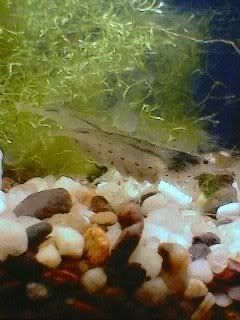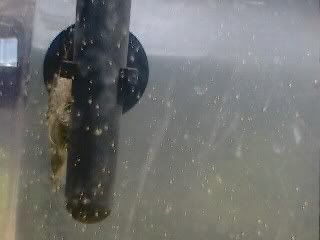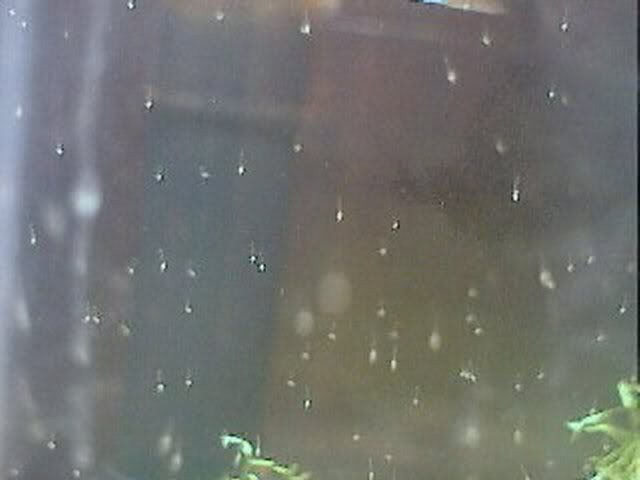My Amano Project
Moderator: Mustafa
- badflash
- Master Shrimp Nut

- Posts: 2542
- Joined: Sat Sep 24, 2005 1:06 pm
- Location: Wappingers Falls, NY
- Contact:
My Amano Project
The eggs were on the swimmerlets on January 10 and this evening (Feb 10) the first batch hatched. She released them all in a period of about 2 hours. I'd say I have between 300-500 zoes!
I'm going to use this thread to chronical what I do and what happens.
Just to lay a basis for those who may not have read the other threads, I have a group of females isolated in a small 2 gallon tank. Righ now I have around a dozen females with eggs, and I expect I'll get a hatch about evey other day for the next month or so.
The zoes are attracted to light, so I used a halogen desk lamp to attract them, then use the "turkey baster of life" to transfer them to my plankton seive, then to my 5 gallon grow-out tank.
The grow out tank is kept at 78 degrees F and has been running for around 2 months with marine rotifers and brine shrimp. I have second thoughts about the brine shrimp, but I haven't been able to get them all. They may bug the zoes, but the won't eat them. I have an open air line in the tank bubbling lightly to keep the water from being stagnet. The light is kept on 24/7.
I feed the tank about a liter of green water AM & PM and siphon off the bottom to make room. The green water is a marine type that also lives in fresh water. I grow it in fresh water, then mix it with 65 PPT salt water to make a 32 PPT feed. I can make it stronger or weaker to keep the tank at around 31 PPT give or a a PPT.
I'm going to use this thread to chronical what I do and what happens.
Just to lay a basis for those who may not have read the other threads, I have a group of females isolated in a small 2 gallon tank. Righ now I have around a dozen females with eggs, and I expect I'll get a hatch about evey other day for the next month or so.
The zoes are attracted to light, so I used a halogen desk lamp to attract them, then use the "turkey baster of life" to transfer them to my plankton seive, then to my 5 gallon grow-out tank.
The grow out tank is kept at 78 degrees F and has been running for around 2 months with marine rotifers and brine shrimp. I have second thoughts about the brine shrimp, but I haven't been able to get them all. They may bug the zoes, but the won't eat them. I have an open air line in the tank bubbling lightly to keep the water from being stagnet. The light is kept on 24/7.
I feed the tank about a liter of green water AM & PM and siphon off the bottom to make room. The green water is a marine type that also lives in fresh water. I grow it in fresh water, then mix it with 65 PPT salt water to make a 32 PPT feed. I can make it stronger or weaker to keep the tank at around 31 PPT give or a a PPT.
- badflash
- Master Shrimp Nut

- Posts: 2542
- Joined: Sat Sep 24, 2005 1:06 pm
- Location: Wappingers Falls, NY
- Contact:
Some pics from Feb 10
Here is one of my many "ladies in waiting"

Here is a shot of the hatch. That "dust" is the little zoes and that brown thing is another amano with her eggs.

Here is a close-up of the zoes- man are they tiny!
 [/img]
[/img]
The aquarium is plastic and pretty scratched up, so the pictures only give the flavor. The little tail hangers are in the 5 gallon tank and quite hard to spot. I have to really look to se them. The are only marginally larger than the rotifers.

Here is a shot of the hatch. That "dust" is the little zoes and that brown thing is another amano with her eggs.

Here is a close-up of the zoes- man are they tiny!
 [/img]
[/img]The aquarium is plastic and pretty scratched up, so the pictures only give the flavor. The little tail hangers are in the 5 gallon tank and quite hard to spot. I have to really look to se them. The are only marginally larger than the rotifers.
- badflash
- Master Shrimp Nut

- Posts: 2542
- Joined: Sat Sep 24, 2005 1:06 pm
- Location: Wappingers Falls, NY
- Contact:
OK, Time for plan B. Most of the larva are gone (but not all). In Mike Noren article it said:
In the French article is says:Therefore the larvae have to be transferred to salt water as soon as possible, at the latest at the 8th day after hatching, because after that they become unable to live in fresh water - or in insufficiently salty brackish water, for that matter.
Looks like I need to let them mature a little in fresh water before I transfer. I feel bad, but there is nothing to be done about it. The next batch is already hatching, so the transfer will probably be Thursday or Friday.After a few days minimum (3 or 4 days), I can siphon the zoes out of the hatching tank, with some plastic air tube, in order to prepare them for the breeding tank.
- xerxeswasachump
- Larva

- Posts: 39
- Joined: Sun Feb 05, 2006 12:06 pm
- Location: Ho-Ho-Kus, NJ
- Contact:
I'm trying to breed my own Amanos too. I've never done anything like this before so i'm really worried about screwing it up. Right now i have two females that are approaching their 3rd week of gestation. I don't have any marine greenwater to give them yet but i was planning on culturing some spirulina for them. Is that any good? I also have some pytoplex-like stuff that i can feed them. I was planning on keeping them in a big jar like that one guy's website. Also, would it be easier to keep the pregnant females in the jar till they release the eggs, then fish them out with a net and put tons of salt in the water for the zoes?
- badflash
- Master Shrimp Nut

- Posts: 2542
- Joined: Sat Sep 24, 2005 1:06 pm
- Location: Wappingers Falls, NY
- Contact:
This is pretty uncharted territory. I would not feed them spirulina as I believe this is a freshwater species. The phyto-plex is probably a better choice. The French article said they used only algae, so this may work.
As far as the transition goes, you could fish out the adults, wait at least 3 days or 4, then over a period of a day or so do water changes to bring the salinity up to 30-34 ppt. DO NOT throw in salt to do this. Mix up marine sea salt at saturation levels and let it bubble for 24 hours or more. Add a few cups at a time. Let it mix totally for an hour or so with the bubbler going. Keep testing until it is above 30 PPT. It is really hard to do a water change without pulling out a bunch of zoes, so filter through a plankton screen so you can return them to the breeder.
The French article said you could just dump them in water with the right salinity. The big problem with that is that the water is not properly aged. You may have the same issue with changing over to salt from fresh. This is why I set up my tank well over a month in advance. Looks like you only have a week or so to prepare.
As far as the transition goes, you could fish out the adults, wait at least 3 days or 4, then over a period of a day or so do water changes to bring the salinity up to 30-34 ppt. DO NOT throw in salt to do this. Mix up marine sea salt at saturation levels and let it bubble for 24 hours or more. Add a few cups at a time. Let it mix totally for an hour or so with the bubbler going. Keep testing until it is above 30 PPT. It is really hard to do a water change without pulling out a bunch of zoes, so filter through a plankton screen so you can return them to the breeder.
The French article said you could just dump them in water with the right salinity. The big problem with that is that the water is not properly aged. You may have the same issue with changing over to salt from fresh. This is why I set up my tank well over a month in advance. Looks like you only have a week or so to prepare.
- xerxeswasachump
- Larva

- Posts: 39
- Joined: Sun Feb 05, 2006 12:06 pm
- Location: Ho-Ho-Kus, NJ
- Contact:
- xerxeswasachump
- Larva

- Posts: 39
- Joined: Sun Feb 05, 2006 12:06 pm
- Location: Ho-Ho-Kus, NJ
- Contact:
- xerxeswasachump
- Larva

- Posts: 39
- Joined: Sun Feb 05, 2006 12:06 pm
- Location: Ho-Ho-Kus, NJ
- Contact:
The websites are on another thread. I think the thread is "my experience breeding amanos" or something like that .
here is the link: viewtopic.php?t=1011
here is the link: viewtopic.php?t=1011
-
chlorophyll
- Shrimp

- Posts: 218
- Joined: Wed Feb 16, 2005 1:22 am
- Location: Hawaii - USA
I think the transfer to salinity is key, but in my experience, the first day is a fine day to do it. However, I still believe they should be acclimated to the new water's chemistry (and Temp, if necessary) in two, preferably 3 steps, for most of the animals to last the first 4 days. Like from fresh to 10 ppt, to 20, to 30, over just an hour is ok, or over 2 or 3 days is fine too. Just so there's some graduality (is that a word, or did I just do a George W?). As when a river empties into sea, it really doesn't tend to go from 0 to 34 in salinity instantly, or even over a few seconds. There's the salt wedge (where larvae would probably tend to stay closer to the surface, where lower saline water reaches further into the sea), and out flow is not that fast in an estuary, and it could be possible (but just my thought) that once out of the river's mouth, larvae could instinctively hold their migration back in the bobbing tide so as not to rush too quickly into higher salinity.
- badflash
- Master Shrimp Nut

- Posts: 2542
- Joined: Sat Sep 24, 2005 1:06 pm
- Location: Wappingers Falls, NY
- Contact:
I still have about 100 floating around. The Mike Noren articles said
Even if that fails and I get only 10% to post larval, I'll be overrun with these shrimp. 30 at a shot is better than cherry shrimp do and look how fast they breed.
I think 3-4 days may be a lot longer than needed and 24 may be closer to what is correct. If the stream only flowed at 5 miles an hour that would be close to 100 miles a day. Where is Japan is there a mountain stream that flows 400 mile to the sea? I think that your gradual salt change actually just gave them time to harden up before going to full salt water.
The french article also saysThere is no need to gradually increase salinity, the larvae have no problem being unceremoniously dumped straight into salt water.
So while you're right about the mechanics of the flow to the sea, both authors say it isn't needed. If letting them harden up for 3-4 days doesn't work, I'll try that.Until recently, I used a very progressive method for putting the larvae into salt water by gradually increasing the salinity, but it turned out that it was useless, since the larvae can go directly into seawater without any problem !
Even if that fails and I get only 10% to post larval, I'll be overrun with these shrimp. 30 at a shot is better than cherry shrimp do and look how fast they breed.
I think 3-4 days may be a lot longer than needed and 24 may be closer to what is correct. If the stream only flowed at 5 miles an hour that would be close to 100 miles a day. Where is Japan is there a mountain stream that flows 400 mile to the sea? I think that your gradual salt change actually just gave them time to harden up before going to full salt water.
Re: My Amano Project
Great idea! Once you are successful with your project you can organize the information in this thread into an article and I can publish it in the articles section of petshrimp.com if you want. It would be of great help to others who want to try the same and also add to the list of available materials that are already out there.badflash wrote: I'm going to use this thread to chronical what I do and what happens.
Last edited by Mustafa on Mon Feb 13, 2006 5:25 pm, edited 1 time in total.
- badflash
- Master Shrimp Nut

- Posts: 2542
- Joined: Sat Sep 24, 2005 1:06 pm
- Location: Wappingers Falls, NY
- Contact:
Feb 13 the first of the shrimp have undergone their first molt. Before they looked more like the movies you see of little sperms. Now they are far smaller than the ghost shrimp I bred, but look to be that exact shape- an upside down seahorse with a pronounced bent tail. Seems a bit soon, but it is what it is. Those that have molted now have visible front legs and I can see them holding food. This is a very good sign. My Pro Scope is not up to pictures, sorry to say.

